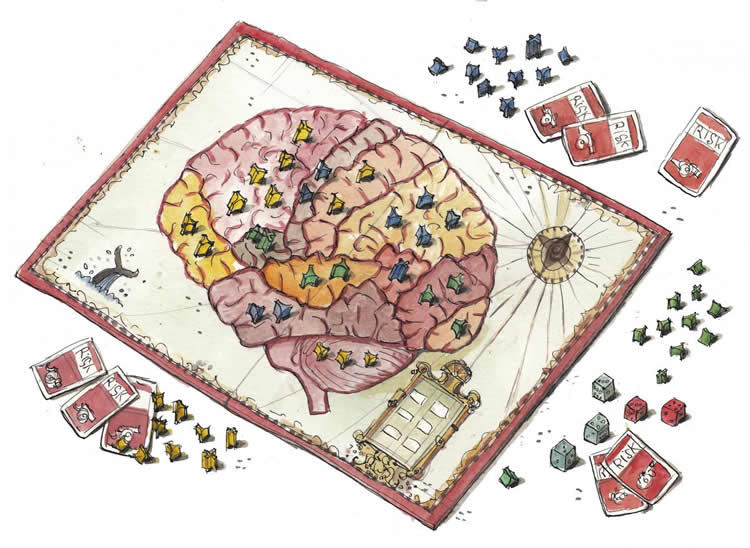Summary: Researchers discover those who were born blind use a brain map, similar to that in people with full vision, to distinguish between objects.
Source: KU Leuven.
Is what you’re looking at an object, a face, or a tree? When processing visual input, our brain uses different areas to recognize faces, body parts, scenes, and objects. Scientists at KU Leuven have now shown that people who were born blind use a ‘brain map’ with a very similar layout to distinguish between these same categories.
Our brain only needs a split second to determine what we’re seeing. The area in our brain that can categorize these visual observations so quickly is the so-called ventral-temporal cortex, the visual brain. Like a map, this region is divided into smaller regions, each of which recognizes a particular category of observations – faces, body parts, scenes, and objects.
Scientists have long wondered whether we’re born with this map, or whether its development relies on the visual input that we receive.
To answer this question, researchers from the KU Leuven Laboratory for Biological Psychology conducted an experiment with people who were born blind – some of them even without eyeballs – and have therefore never processed any visual information.

They asked the blind participants to listen to sounds from four categories: laughing, kissing, and lip smacking for faces; hand clapping and footsteps for body parts; forest and beach sounds for scenes; and a clock, washing machine, and car for objects. Meanwhile, a scanner measured the activity in their visual brain.
“We found that blind individuals also use the map in the visual brain,” Professor Hans Op de Beeck explains. “Their visual brain responds in a different way to each category. This means that blind people, too, use this part of the brain to differentiate between categories, even though they’ve never had any visual input. And the layout of their map is largely the same as that of sighted people. This means that visual experience is not required to develop category selectivity in the visual brain.”
But these findings also raise new questions. For one thing, sounds are very different from visual input such as images and videos, so what exactly is being processed in blind people’s visual brain? Further research will have to show.
Source: Ilse Frederickx – KU Leuven
Image Source: NeuroscienceNews.com image is credited to Joris Snaet.
Original Research: Full open access research for “Development of visual category selectivity in ventral visual cortex does not require visual experience” by Job van den Hurk, Marc Van Baelen, and Hans P. Op de Beeck in PNAS. Published online May 15 2017 doi:10.1073/pnas.1612862114
[cbtabs][cbtab title=”MLA”]KU Leuven “Blind People Have Brain Map For ‘Visual’ Observations Too.” NeuroscienceNews. NeuroscienceNews, 17 May 2017.
<https://neurosciencenews.com/blind-visual-map-6698/>.[/cbtab][cbtab title=”APA”]KU Leuven (2017, May 17). Blind People Have Brain Map For ‘Visual’ Observations Too. NeuroscienceNew. Retrieved May 17, 2017 from https://neurosciencenews.com/blind-visual-map-6698/[/cbtab][cbtab title=”Chicago”]KU Leuven “Blind People Have Brain Map For ‘Visual’ Observations Too.” https://neurosciencenews.com/blind-visual-map-6698/ (accessed May 17, 2017).[/cbtab][/cbtabs]
Abstract
Development of visual category selectivity in ventral visual cortex does not require visual experience
To what extent does functional brain organization rely on sensory input? Here, we show that for the penultimate visual-processing region, ventral-temporal cortex (VTC), visual experience is not the origin of its fundamental organizational property, category selectivity. In the fMRI study reported here, we presented 14 congenitally blind participants with face-, body-, scene-, and object-related natural sounds and presented 20 healthy controls with both auditory and visual stimuli from these categories. Using macroanatomical alignment, response mapping, and surface-based multivoxel pattern analysis, we demonstrated that VTC in blind individuals shows robust discriminatory responses elicited by the four categories and that these patterns of activity in blind subjects could successfully predict the visual categories in sighted controls. These findings were confirmed in a subset of blind participants born without eyes and thus deprived from all light perception since conception. The sounds also could be decoded in primary visual and primary auditory cortex, but these regions did not sustain generalization across modalities. Surprisingly, although not as strong as visual responses, selectivity for auditory stimulation in visual cortex was stronger in blind individuals than in controls. The opposite was observed in primary auditory cortex. Overall, we demonstrated a striking similarity in the cortical response layout of VTC in blind individuals and sighted controls, demonstrating that the overall category-selective map in extrastriate cortex develops independently from visual experience.
“Development of visual category selectivity in ventral visual cortex does not require visual experience” by Job van den Hurk, Marc Van Baelen, and Hans P. Op de Beeck in PNAS. Published online May 15 2017 doi:10.1073/pnas.1612862114






